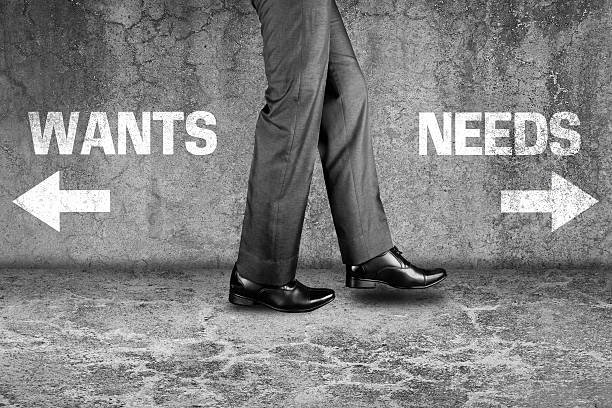Have you ever stood in a store, holding an item in your hand, and asked yourself, “Do I really need this, or do I just want it?” If so, you’re not alone. In a world filled with endless choices and persuasive marketing, distinguishing between needs and wants can feel like navigating a financial minefield. But here’s the truth: understanding the difference between the two is the cornerstone of smart money management.
Whether you’re trying to stick to a budget, save for a big goal, or simply avoid buyer’s remorse, knowing how to separate essential spending from discretionary splurges is a game-changer. In this blog, we’ll break down the difference between needs and wants, explore why it matters, and share practical tips to help you make smarter spending decisions.
What Are Needs and Wants?
At its core, the difference between needs and wants is simple:
Needs are the essentials—the things you must have to survive and function in daily life.

Wants are the extras—the things that make life more enjoyable but aren’t strictly necessary.

However, the line between the two isn’t always black and white. For example, while food is a need, dining at a fancy restaurant is a want. Similarly, while shelter is a need, upgrading to a luxury apartment might fall into the want category.
Understanding this distinction is key to creating a budget that works for you and aligns with your financial goals.
Why Differentiating Between Needs and Wants Matters
1. It Helps You Prioritize Spending
When you know what’s essential and what’s optional, you can allocate your money more effectively. This ensures that your basic needs are always covered, while still leaving room for the occasional treat.
2. It Reduces Financial Stress
Living paycheck to paycheck is stressful. By focusing on needs first, you can avoid overspending on wants and ensure you have enough to cover your essentials.
3. It Supports Long-Term Financial Goals
Every dollar you save by cutting back on discretionary spending is a dollar you can put toward bigger goals, like building an emergency fund, paying off debt, or investing for the future.
4. It Encourages Mindful Spending
Differentiating between needs and wants forces you to pause and reflect before making a purchase. This mindfulness can help you avoid impulse buys and make more intentional decisions.
For more on the power of intentional spending, check out our blog on Mindful Spending: What It Is and Why It Matters.
How to Identify Your Needs and Wants
1. Start with the Basics
Make a list of your essential needs. These typically include:
- Housing (rent or mortgage)
- Utilities (electricity, water, internet)
- Groceries
- Transportation
- Healthcare
- Basic clothing
These are the non-negotiables—the expenses you can’t live without.
2. Evaluate Your Wants
Next, list your discretionary spending. These are the things that enhance your life but aren’t strictly necessary. Examples include:
- Dining out
- Entertainment (movies, concerts, streaming services)
- Luxury items (designer clothes, high-end electronics)
- Vacations
- Hobbies
3. Ask Yourself Key Questions
When you’re unsure whether something is a need or a want, ask yourself:
- Can I live without this?
- Does this align with my financial goals?
- Will this purchase bring me long-term satisfaction?
If the answer is no, it’s likely a want.
Practical Tips for Balancing Needs and Wants
1. Create a Budget That Reflects Your Priorities
A well-structured budget is your best tool for managing needs and wants. Start by allocating funds to your essential expenses, then set aside a portion for discretionary spending. This way, you can enjoy life’s little luxuries without jeopardizing your financial stability.
2. Use the 50/30/20 Rule
This popular budgeting framework divides your income into three categories:
- 50% for Needs: Essential expenses like housing, utilities, and groceries.
- 30% for Wants: Discretionary spending on things like dining out and entertainment.
- 20% for Savings and Debt Repayment: Building an emergency fund, saving for retirement, or paying off debt.
This rule provides a clear guideline for balancing needs and wants while still prioritizing your financial future.
3. Practice Delayed Gratification
If you’re tempted by a non-essential purchase, try waiting 24-48 hours before buying it. Often, the initial urge to splurge will fade, helping you avoid unnecessary spending.
4. Track Your Spending
Keeping tabs on where your money goes can reveal surprising insights. You might discover that small, frequent purchases (like daily coffee runs) add up quickly, eating into your budget.
5. Set Financial Goals
Having clear goals—like saving for a vacation or paying off a credit card—can help you stay motivated to prioritize needs over wants.
Real-Life Examples of Needs vs. Wants
Let’s put theory into practice with some everyday scenarios:
1. Transportation
- Need: A reliable car to get to work or public transportation fares.
- Want: A brand-new luxury vehicle with all the bells and whistles.
2. Clothing
- Need: A winter coat to stay warm during cold months.
- Want: A designer handbag or the latest fashion trends.
3. Food
- Need: Groceries to prepare meals at home.
- Want: Eating out at restaurants or ordering takeout.
4. Entertainment
- Need: Basic internet access for work or school.
- Want: Subscriptions to multiple streaming services or premium cable packages.
The Emotional Side of Needs and Wants
It’s important to acknowledge that spending isn’t just about logic—it’s also tied to emotions. Sometimes, we buy things to cope with stress, boost our mood, or keep up with others. Recognizing these emotional triggers can help you make more mindful decisions.
For example, if you often shop when you’re feeling down, try finding healthier ways to cope, like going for a walk, calling a friend, or practicing mindfulness.
Final Thoughts: Finding Your Balance
Differentiating between needs and wants isn’t about depriving yourself—it’s about making choices that align with your values and goals. By focusing on what truly matters, you can create a financial plan that supports both your present and future self.
Remember, it’s okay to indulge in wants occasionally. The key is to do so consciously and within your means. After all, life is about balance, not extremes.
Ready to take control of your spending and build a healthier financial future? Explore more resources on mindful living and personal growth at Venzec.icu. Your journey to financial clarity starts today!









